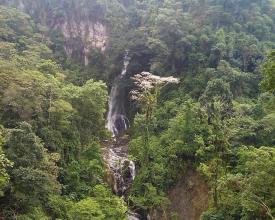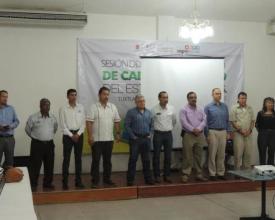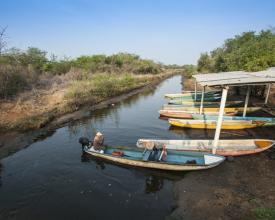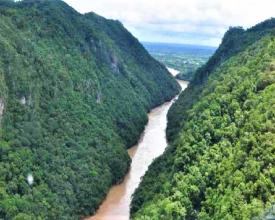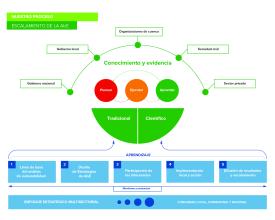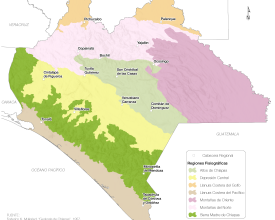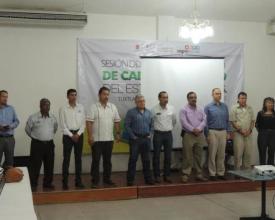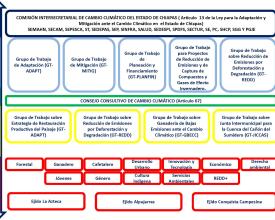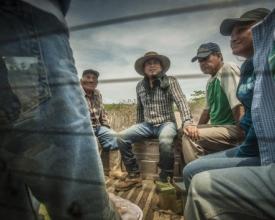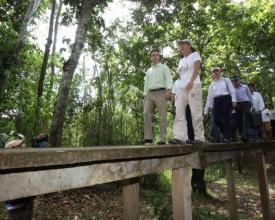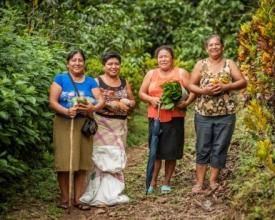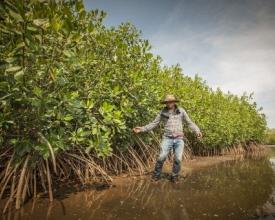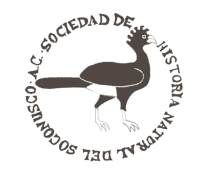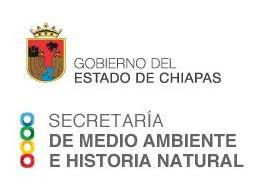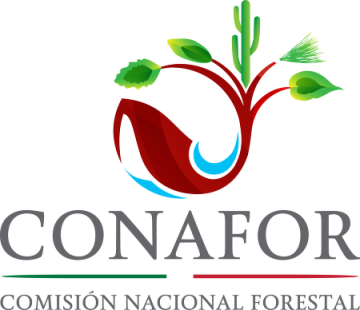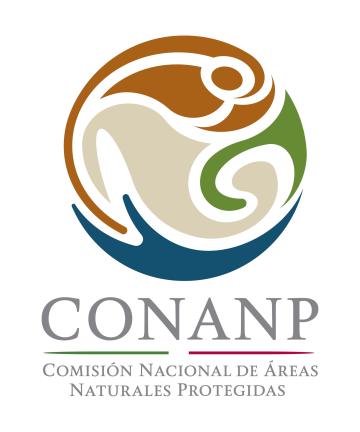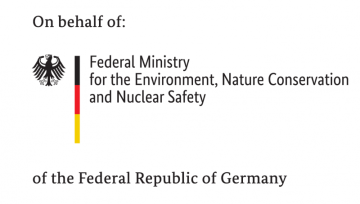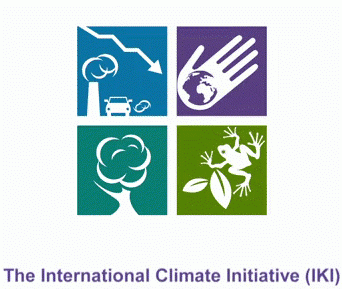
Gouvernance pour l'adaptation au Chiapas - Mexique
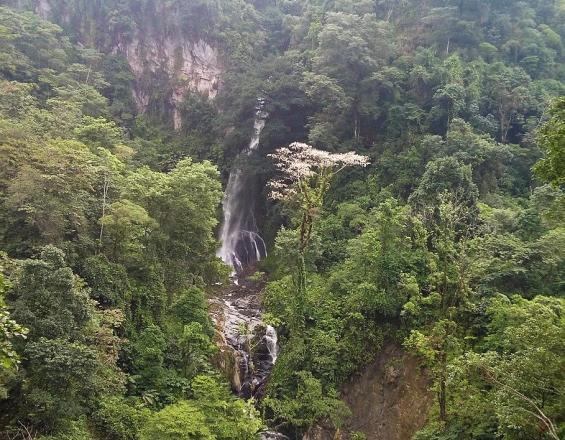
Le Chiapas est très diversifié et très vulnérable au changement climatique. Il fait partie des États mexicains aux revenus les plus faibles et la majorité de sa population vit dans des zones rurales. Dans ce contexte, les communautés locales mettent en œuvre des mesures de conservation et d'EbA, mais il est nécessaire de renforcer le financement et d'améliorer la participation et les mécanismes de gouvernance à plusieurs niveaux.
Cette solution met en place une gouvernance multidimensionnelle et un modèle participatif (BB1) et utilise une approche écosystémique (BB2). Elle renforce le Conseil consultatif sur le changement climatique du Chiapas (CCAD), qui est la plateforme de participation publique et l'organe consultatif de la Commission de coordination intersecrétariats sur le changement climatique. La solution consiste à réactiver ce conseil pour qu'il devienne un pont entre l'élaboration des politiques et les mesures d'adaptation locales.
Contexte
Défis à relever
- Le Chiapas est particulièrement exposé aux phénomènes hydrométéorologiques, tels que les cyclones tropicaux, les inondations et les sécheresses, qui ont déjà causé des pertes humaines ainsi que des coûts économiques et sociaux élevés.
- Entre 1999 et 2009, le Chiapas a connu 21 catastrophes, le secteur agricole étant le plus touché par les événements climatiques.
- Les organes actuels de lutte contre le changement climatique du Chiapas manquent de liens avec les plateformes de gouvernance des bassins hydrographiques de l'État, ce qui entrave l'application intégrale de l'EbA et des approches à l'échelle du bassin.
- Bien que la loi sur le changement climatique de l'État du Chiapas (2013) ait créé le Conseil consultatif sur le changement climatique, celui-ci est resté inactif depuis sa constitution en 2014, en raison du caractère volontaire (non rémunéré) des membres du Conseil. Cela a laissé une lacune dans la promotion de la participation du public dans les politiques d'adaptation et d'atténuation du Chiapas.
- Les décideurs ne sont souvent pas suffisamment informés sur les services écosystémiques et leurs avantages pour l'adaptation.
Emplacement
Traiter
Résumé du processus
- Le Chiapas est très diversifié et très vulnérable au changement climatique. Il fait partie des États mexicains aux revenus les plus faibles et une grande partie de sa population vit dans des zones rurales. Le développement économique et l'EbA peuvent donc apparaître comme des objectifs concurrents. Le renforcement de l'institutionnalité du Chiapas en matière de changement climatique est stratégique pour l'intégration de l'EbA en tant qu'objectif de développement au Chiapas et pour l'affectation d'un budget aux mesures d'EbA. Les ejidos et les organisations de bassins versants du Chiapas mettent en œuvre des mesures d'EbA, mais un soutien financier supplémentaire est nécessaire. Le conseil consultatif est essentiel pour combler le fossé entre l'élaboration des politiques au niveau de l'État et les besoins d'adaptation au niveau local. Par conséquent, cette solution a permis i) de renforcer le conseil consultatif et ii) de partager des preuves et des expériences sur les avantages des mesures d'EbA.
- D'autres travaux sont nécessaires pour que le conseil consultatif puisse influencer davantage l'élaboration des politiques en informant sur les avantages de l'EbA : i) améliorer les mécanismes de participation des organismes de bassin et des représentants des ejidos de l'État du Chiapas et ii) améliorer les mécanismes d'intégration des connaissances locales et traditionnelles dans son travail.
Blocs de construction
Une gouvernance multidimensionnelle et participative pour l'adaptation
Le système d'État sur le changement climatique est le mécanisme permanent de communication et de coordination des entités de l'État et des municipalités sur les politiques relatives au changement climatique. Ses membres sont les suivants : La Commission de coordination intersecrétariats sur le changement climatique (CCISCC), le Conseil consultatif sur le changement climatique (CCAC), le secrétaire d'État à l'environnement, les délégations fédérales, les maires et le Congrès de l'État. Bien que le CCAC ait été créé en 2014, il était inopérant, laissant une lacune dans la promotion de la participation publique à la formulation et à la mise en œuvre des politiques de lutte contre le changement climatique.
L'UICN a mené une analyse et des entretiens afin d'identifier les raisons de cette situation : 1) le manque de temps dû à la fonction honorifique (non rémunérée) du conseiller et 2) l'absence d'un règlement intérieur prévoyant des règles de révocation en cas d'absence prolongée. L'UICN et le Secrétariat d'État à l'environnement ont donc profité de l'élan de 2017 pour promouvoir la nomination de nouveaux conseillers par le président de la CCISCC et l'élaboration de son règlement intérieur. Ils ont également veillé à inclure un groupe de travail sur l'adaptation.
Facteurs favorables
L'amélioration de la gouvernance participative multidimensionnelle a été possible grâce à une série de facteurs favorables :
- Volonté et engagement politiques
- Engagement des ONG
- Engagement des communautés locales ayant de l'expérience dans les actions de conservation
- la couverture médiatique
- Soutien des projets d'adaptation en cours, tant au niveau de la coopération internationale que des programmes nationaux.
Leçon apprise
- Afin de constituer une plateforme de gouvernance multidimensionnelle, le conseil consultatif devrait promouvoir l'intégration multisectorielle, mais aussi l'intégration à plusieurs niveaux. Cela implique l'inclusion de représentants d'Ejido, d'acteurs locaux et de peuples indigènes afin que ces acteurs puissent présenter leurs propositions, leurs besoins d'adaptation (en particulier pour l'EbA) et leurs possibilités d'atténuation aux autorités de l'État.
- Étant donné que plus de 50 % de la population du Chiapas vit dans des zones rurales et que certains conseillers vivent loin de la capitale du Chiapas, il est important de développer des mécanismes décentralisés de représentation et de participation à la prise de décision. Dans le cas contraire, le cadre institutionnel risque de ne pas atteindre son objectif.
- Des espaces tels que le Congrès national sur la recherche en matière de changement climatique, soutenu ces dernières années par le Conseil consultatif, offrent des possibilités de diffusion et de mise en réseau permettant aux acteurs, tels que les Ejidos, les chercheurs et la société civile, de présenter leurs besoins et leurs propositions en matière de changement climatique.
Note : L'Ejido est un système de propriété foncière et une forme d'organisation communale, où les communautés sèment pour s'entraider.
Gouvernance pour l'adaptation grâce à une approche écosystémique
Le conseil consultatif sert de véhicule pour faire remonter à la Commission les expériences locales et les preuves des avantages de l'adaptation basée sur les écosystèmes. Pour relever les défis de l'adaptation, il est régi par plusieurs critères, parmi lesquels : identifier et réduire la vulnérabilité de la société et des écosystèmes ; prendre en compte les scénarios de changement climatique dans la planification territoriale ; étudier et renforcer la résilience et la capacité d'adaptation des systèmes naturels et humains ; tirer parti des opportunités générées par les nouvelles conditions climatiques et ; promouvoir la sécurité alimentaire, la productivité et la conservation des écosystèmes. Pour faciliter l'examen des questions techniques, le Conseil a créé quatre groupes de travail, le dernier étant celui sur l'adaptation. Ce dernier groupe espère consolider un espace d'échanges et de synergies multidisciplinaires, où ses membres pourront plaider en faveur de l'EbA. La contribution du Conseil à la gouvernance pour l'adaptation dépendra des mécanismes qu'il pourra faciliter pour l'intégration des organisations de base et de la société civile(ejidos). S'il adoptait également une approche de la gestion territoriale à l'échelle du bassin et collaborait avec les autres groupes de travail, il pourrait construire un modèle de gouvernance encore plus collégial, écosystémique et résilient.
Facteurs favorables
- Disposer de preuves de l'efficacité de l'EbA pour intégrer l'EbA au sein du conseil consultatif : Des études de vulnérabilité communautaire et des expériences d'application de mesures d'EbA dans les ejidos des bassins versants supérieurs des rivières Coatán et Cahoacán, et sur la côte (Tapachula) ont été développées et partagées avec le Conseil.
- Partager les données probantes à grande échelle pour intégrer l'EbA : les études ont été présentées au VIIe Congrès national sur la recherche en matière de changement climatique, ce qui a permis de créer des réseaux, de sensibiliser et d'échanger des expériences sur l'efficacité de l'EbA.
Leçon apprise
- Les ressources financières constituent un obstacle à la mise en œuvre de l'EbA. Atteindre les décideurs politiques pour qu'ils incluent l'EbA dans les priorités de développement de l'État et qu'ils lui attribuent un budget reste un défi. Bien que les conseillers soient ouverts à l'idée d'exploiter les approches de l'EbA auprès des décideurs politiques, il est encore nécessaire de renforcer les liens entre le système institutionnel de lutte contre le changement climatique de l'État et les organisations de gestion des bassins versants/des ressources.
- L'EbA peut avoir un impact plus important en complétant les actions et en reconnaissant les synergies avec d'autres stratégies, telles que l'atténuation/la réduction des émissions (par exemple REDD+) et la réduction des risques de catastrophe. Il s'agit là d'un moyen pertinent d'élargir l'ordre du jour du Conseil, qui a eu tendance à se concentrer davantage sur les questions d'atténuation.
- Pour parvenir à une gouvernance multidimensionnelle, écosystémique, durable et participative, ces institutions de la CC et les organisations de base doivent faire preuve d'une plus grande coordination au fil du temps, y compris la capacité d'évaluer conjointement l'efficacité des politiques d'adaptation et les co-bénéfices de l'atténuation.
Impacts
- Activation du Conseil consultatif sur le changement climatique du Chiapas en tant que plateforme pour une participation sociale informée et responsable à l'élaboration des politiques.
- Intégration d'un groupe de travail sur l'adaptation au sein du conseil, chargé de mener des discussions sur les mesures d'adaptation au niveau de l'État, y compris l'EbA.
- Préparation d'un règlement interne pour fixer les règles de participation et les fonctions des membres du Conseil consultatif et de ses groupes de travail.
- Consultation publique pour la stratégie nationale REDD+ menée par le conseil, au cours de laquelle les synergies entre EbA et REDD+ ont été explorées.
- Collecte et traitement de données probantes sur les avantages de l'adaptation fondée sur les écosystèmes (EbA) pour la sécurité alimentaire et hydrique (sur la base des expériences de mise en œuvre de mesures EbA dans les ejidos des bassins fluviaux de Coatán et de Cahoacán, tant dans la partie supérieure que sur la côte).
Bénéficiaires
Conseil consultatif sur le changement climatique, qui est actif et dispose d'un groupe de travail sur l'adaptation.
La Commission de coordination intersecrétariats sur le changement climatique du Chiapas, conseillée par le Conseil consultatif.
Les habitants et les organisations du Chiapas, qui peuvent participer.
